Year - 2026
Departure Date - sep 4
Return Date - sep 20
This Tour Is Open -
Tour Type - Tourist/Railfan tour
$7,975 - Double Room Occupancy
$1,355 - Single Room Supplement
$3,000 - Deposit To Hold Space
-$300 - Early Bird Discount
Book By Dec 1, 2025
Final Payment Due By - jun 4, 2026
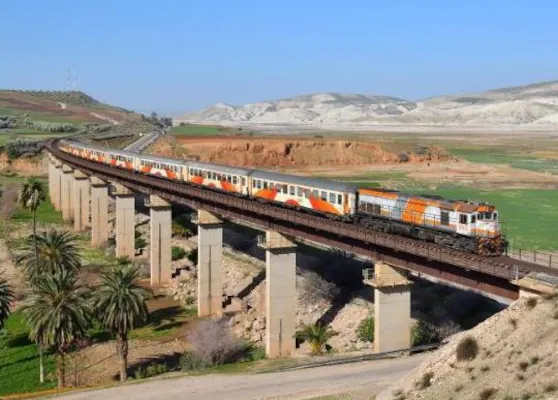
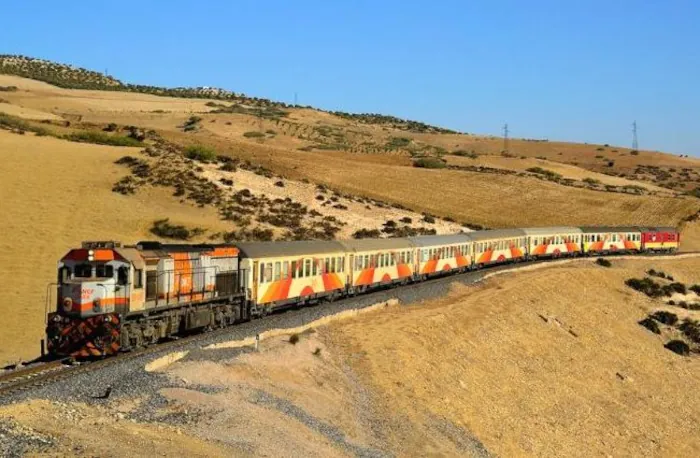
Embark on an unforgettable journey through Morocco, a land where ancient history, vibrant culture, and stunninglandscapes converge. This comprehensive tour, using Morocco’s efficient and scenic train network, takes you through the country’s most iconic destinations: Casablanca, Tangier, Fes, Ouarzazate, Merzouga, Zagora, Ait Ben Haddou, and Marrakech. Each stop offers a unique glimpse into Morocco’s rich tapestry, from bustling coastal cities to timeless desert oases, all connected by the comfort and charm of train travel, with supplementary road transfers where needed. From the sparkling Atlantic shores of Casablanca to the ochre ramparts of Marrakech, this adventure combines the speed of modern rail with the romance of desert caravans and kasbahs.
Begin in Casablanca, the cosmopolitan heart of Morocco, with its grand architecture and coastal flair, where modernity meets tradition. From here, board a train to Tangier, a historic port city perched on the edge of Europe and Agrica, where mediterranean and african influences blend. Wander the labyrinthine medina, sip mint tea at a cliffside café, and feel the crossroads of cultures at the Kasbah.
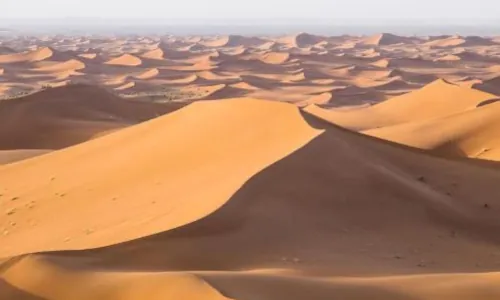
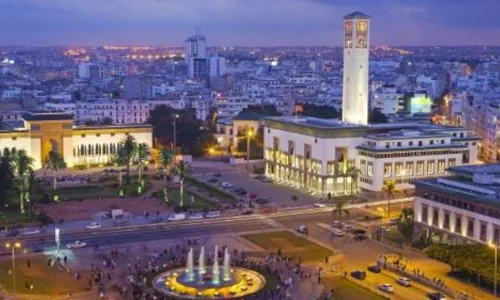

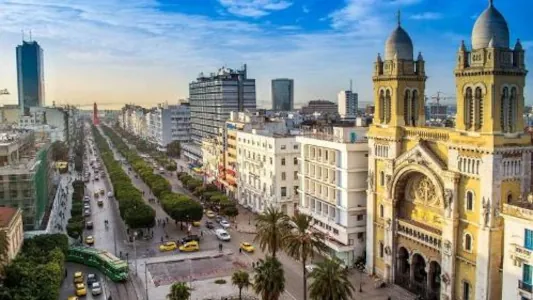
Discover Rabat and Fes, two of Morocco’s grand imperial cities—where French boulevards, bustling souks and ancient medinas sit side by side. Explore nearby Meknes, famed for its monumental gates and blend of Arabic and Andalusian heritage. Wander the UNESCO World Heritage Site of Volubilis, a remarkably well-preserved Roman city and one of Morocco’s most significant archaeological treasures, for a fascinating glimpse into Morocco’s ancient past.
Venture inland across the High Atlas Mountains to the cinematic landscapes of Ouarzazate and the fortified village of Ait Ben Haddou, a UNESCO-listed ksar and a masterpiece of clay architecture, famously featured in films like Gladiator. Travel to the edge of the desert at Zagora, a tranquil oasis steeped in Saharan lore, offering a glimpse into Morocco’s famed desert heritage, and enjoy an unforgettable desert camp experience at Merzouga, where golden dunes and star-filled skies await.
Finally, arrive in Marrakech, the vibrant “Red City,” where the Jemaa el-Fnaa square pulses with storytellers, musicians, snake charmers and spice-scented souks, and centuries of history echoes from every tiled courtyard and minaret. Along the way, enjoy a seamless mix of high-speed rail, scenic coach travel and regional trains, experiencing Morocco’s diversity in comfort and style. From coastal breezes to desert sunsets, ancient medinas to cinematic kasbahs, this journey captures the soul of Morocco in all its diversity and wonder. Pack your sense of adventure and prepare to be enchanted by a land where every stop tells a story.
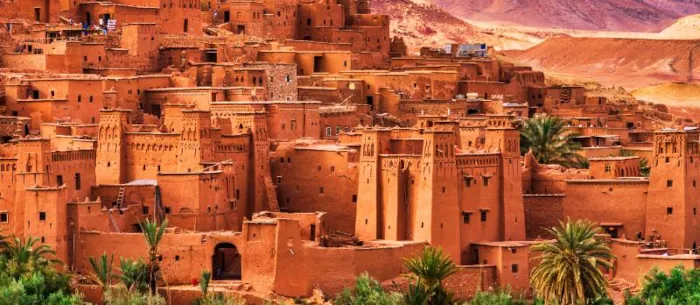
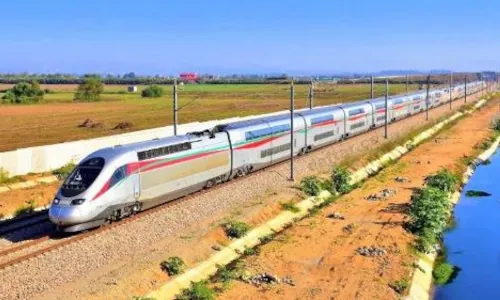
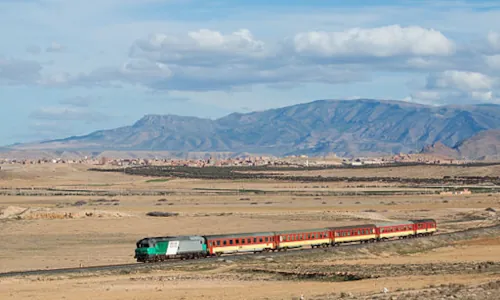
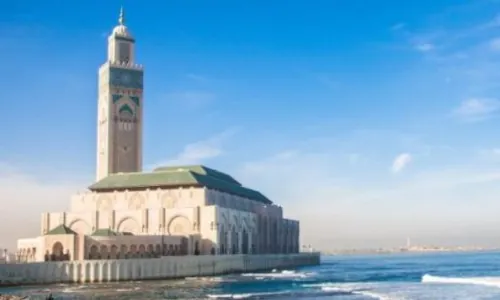
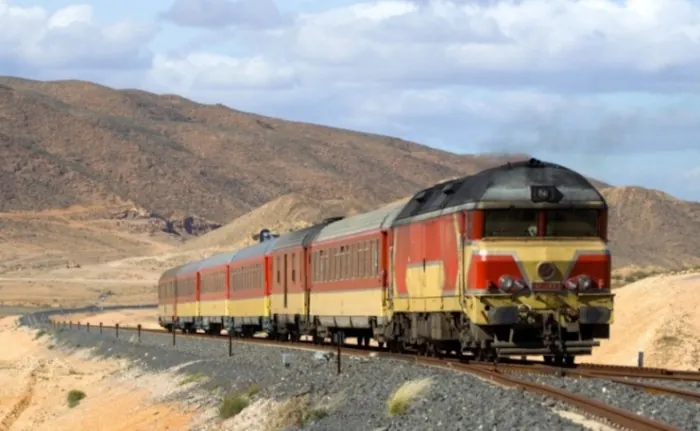
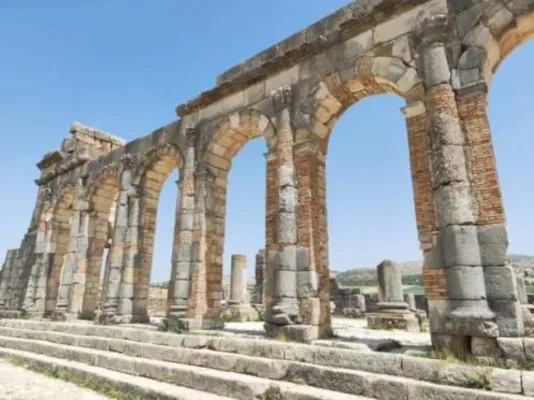
Upon arrival in Casablanca, you’ll be met and transferred to our hotel. Check in is available from 2.00pm. Your tour starts this evening with Welcome drinks followed by a joyful welcome dinner including drinks to meet your tour leader and your fellow travellers.
Casablanca, Morocco’s largest city and principal economic centre, offers a fascinating blend of tradition and modernity. With its sweeping Atlantic coastline, grand boulevards, and striking Art Deco architecture, the city reflects its French colonial past while remaining deeply rooted in Moroccan culture. Casablanca rose to prominence in the early 20th century as a key port and commercial hub and today stands as a vibrant metropolis filled with cultural contrasts. Its most iconic landmark, the Hassan II Mosque, sits dramatically on the ocean’s edge and is one of the largest mosques in the world, offering a spectacular introduction to Morocco’s architectural grandeur.
It’s our usual pattern to meet at 6pm for drinks before heading to dinner, usually booked for 7pm, so we encourage you to ensure your flight arrives in time to join the fun.
Overnight: Hotel Barceló Anfa , Casablanca
🍽 dinner
This morning after breakfast we’ll visit the spectacular Hassan II Mosque, one of the largest and most impressive mosques in the world, perched dramatically on a promontory overlooking the Atlantic Ocean, and standing as a testament to Morocco’s architectural prowess, cultural heritage, and spiritual significance. Completed in 1993, the mosque’s construction involved over 10,000 artisans and workers, showcasing intricate Moroccan craftsmanship, and is considered a masterpiece of modern engineering, with its unique glass floor in the prayer hall looking down on the ocean below. Its minaret, soaring 210 metres, is the tallest in the world, topped with a laser beam pointing toward Mecca.
After enjoying lunch at a local restaurant, we’ll set out on a short city walk to take in Casablanca’s architectural contrasts, from French colonial façades to sleek modern developments. The remainder of the afternoon and evening are at leisure to relax at the hotel, explore more of the city independently, or enjoy Casablanca’s vibrant café culture.
Overnight: Hotel Barceló Anfa , Casablanca
🍽 breakfast, lunch
After breakfast and checking out we’ll transfer to the railway station and settle into your First Class seats on the Al Boraq train, Africa’s first highspeed TGV, for a comfortable and scenic journey north to Tangier, the gateway between Europe and Africa. On the first part of the journey, the train skirts the Atlantic coast, passing urban outskirts, green fields, small villages, and offers occasional ocean views before transitioning to fertile plains and agricultural lands, with olive groves, wheat fields, and distant views of the Rif Mountains as you approach Tangier.
Tangier’s strategic location has made it a coveted prize for centuries, shaped by Phoenician, Roman, Berber, Arab, and European influences. From the 15th century, it was controlled by the Portuguese, Spanish, and British before becoming an international zone in the 20th century, attracting artists, writers, and spies like Paul Bowles, William S. Burroughs, and Ian Fleming. This bohemian legacy, combined with its role as a trade and cultural hub, gives Tangier a unique, cosmopolitan vibe.
On arrival at Tanger Ville station, we’ll transfer directly to our hotel and enjoy lunch before embarking on a guided walking tour of the intriguing and atmospheric old city, ‘Where Europe Meets Africa’, with our expert local guide. The white-washed Medina, the historic old city of Tangier, is a labyrinth of narrow alleys filled with colorful souks, spice markets, and historic homes, and will give you a taste of what’s to come on this tour. While here, we’ll pay a visit to the American Legation Museum to explore and better understand Tangier’s international history and Moroccan-American ties.
We’ll also visit the Kasbah of Tangier, a fortified area situated on a hilltop on the northern edge of the medina offering panoramic views of the port and Gibraltar, and the location of the 17th-century Dar el-Makhzen Palace, formerly a Sultan’s palace and now home to the Museum of Moroccan Arts, showcasing Moroccan artifacts and Andalusian influences.We’ll return to the hotel for some time to freshen up before regrouping toenjoy traditional Moroccan cuisine at a renowned restaurant in the old town.
Overnight: Grand Hotel Villa De France , Tangier
🍽 breakfast, lunch, dinner
This morning after breakfast and checking out, we’ll return to Tanger Ville Station and again take our first class seats, this time on the comfortable train to Fes. You’ll be able to have some lunch at leisure during the journey from the buffet car.
The journey from Tangier to Fes offers a window into Morocco’s northern heartland, transitioning from coastal plains to rolling hills and fertile valleys. Departing Tangier, the train passes through the city’s outskirts, revealing suburban areas and glimpses of the Rif Mountains to the east. The route then crosses the lush Gharb-Chrarda-Béni Hssen region, known for its agricultural fields, olive groves, and citrus orchards - you’ll see small villages, farmland, and occasional rivers like the Loukkos. The landscape then becomes hillier, with undulating plains and distant views of the Middle Atlas foothills. As you approach Fes, the terrain grows more rugged, dotted with olive trees and wheat fields.
Fes (or Fez), is Morocco’s oldest imperial city and its spiritual, cultural, and intellectual epicentre. Founded in 789 CE, Fes is home to the world’s oldest continuously operating university, Al-Qarawiyyin, and a UNESCO-listed medina (Fes el-Bali) that feels like stepping into a medieval time capsule, with donkey carts navigating a maze of over 9,000 alleys, and artisans crafting leather, metal, and textiles as they have for centuries. Often called the “Athens of Africa,” Fes has been a centre of learning, religion, and craftsmanship for over a millennium and flourished as a hub of Islamic scholarship and trade, connecting sub-Saharan Africa, Europe, and the Middle East.
Upon arrival in the early afternoon, we’ll transfer directly to our hotel and check in. The rest of the afternoon is yours to explore a bit of Fes on your own, or relax in your comfortable accommodation. This evening, we’ll gather for dinner at our hotel and enjoy beautiful views over the city, as the sun sets over the rooftops and the call to prayer echoes through the evening air.
Overnight: Riad Al Salam , Fes
🍽 breakfast, dinner
vThis morning after breakfast, we’ll set out to explore Fes with our expert local guide first by coach and then on foot.
We’ll start with a panoramic view of Fes to get our bearings, and a look at the magnificent exterior of the Royal Palace, the official residence of the Moroccan royal family. The palace’s foundations date to the Marinid dynasty, who established Fes el-Jdid (“New Fes”) in 1276 as an administrative and royal enclave separate from Fes el-Bali (the old medina). The palace’s most iconic feature, the massive Bronze Gates of Place des Alaouites, are adorned with intricate zellige tilework, carved cedarwood, and polished brass. Crafted by master artisans, the gates reflect Alaouite opulence and Moroccan artistry.
We’ll then visit the nearby Jewish Quarter (Mellah), and the historic 17th-century restored gem, Ibn Danan Synagogue. Established in the 15th century under the Marinid dynasty, the Mellah is one of Morocco’s oldest Jewish quarters, reflecting Fes’ historical role as a multicultural hub, and showcasing the city’s centuries-long coexistence of Muslim, Jewish, and Berber communities. The Marinids relocated Fes’ Jewish population from Fes el-Bali (the old medina) to Fes el-Jdid (the new medina), near the Royal Palace, ostensibly for protection under the sultan’s authority, and it thrived for the next 500 years, being home to 20,000 people at its peak. By the 19th century, overcrowding and economic challenges emerged and by the mid 20th century, many Jews had moved to Casablanca, seeking modern opportunities, or emigrated to the newly established Israel, reducing the population to just a few hundred today. In the late 20th century, efforts to preserve Morocco’s Jewish heritage, supported by King Mohammed VI, UNESCO and other international organisations, led to the restoration of key sites, including the Ibn Danan Synagogue. The Mellah’s Jewish Cemetery, with 13,000 graves, was also preserved.
Next, after a visit to a traditional ceramic workshop, we’ll venture into the famous Fes el-Bali, the UNESCO listed medina and the extraordinary medieval heart of Fes. This labyrinthine car-free medina offers a glimpse into a living city where centuries-old traditions continue to thrive. While here, we’ll visit one of the oldest theological schools in the world, the Madrasa Bou Inania, built in 1350 and a gem of Moroccan architecture, with intricate mosaics, carved plaster, and a serene courtyard; and then the Chouara Tannery, one of Morocco’s most iconic sights – an 11th-century tannery featuring colorful vats where leather is dyed using traditional methods, including pigeon droppings, lime, and natural dyes like saffron or indigo an unforgettable sight of colour and craft. We’ll enjoy a late traditional tajine lunch in a courtyard restaurant in the medina before returning to the hotel late in the afternoon for an evening at leisure.
Overnight: Riad Al Salam , Fes
🍽 breakfast, lunch
Today is all yours - relax at the hotel, venture out and revisit your favourite corners of the medina, or explore things further afield.For those who are interested in getting up close with ancient Moroccan tradition andart, you might like to join a calligraphy workshop as our guest and learn the basics of Arabic calligraphy from a local artist. You’ll get to not only see a master at work, but also try your hand at this elegant, centuries-old craft.
Overnight: Riad Al Salam, Fes
🍽 breakfast
After breakfast and check out, we’ll hand our luggage over to travel separately and we’ll transfer to the station and board a short train ride to Meknes, one of Morocco’s “imperial” cities but a less touristy destination than the others - Fes, Marrakech and Rabat.
Known as the “Versailles of Morocco” for its grand architecture under Sultan Moulay Ismail (1672–1727), Meknes was founded in the 11th century, originally as a military settlement, before rising to prominence as Morocco’s capital under Moulay Ismail, who transformed it into a fortified city with monumental gates, vast palaces, and sprawling granaries. The Meknes Medina, another but less crowded UNESCO World Heritage Site, preserves this legacy alongside vibrant souks and artisanal traditions, blending Berber, Arab, and Andalusian influences.
We’ll stop here to meet our expert local guide and explore the historic medina, souk, and main square, and visit the sultan’s mausoleum and the imposing granaries - all that remains of his grand vision to create an African Versailles. Our private coach will be on hand to take us to the next stop on our adventure today - another UNESCO World Heritage site, the nearby ancient Roman city of Volubilis, one of the empire’s most remote outposts, and one of Morocco’s most significant archaeological gems. This remarkably well-preserved Roman city, set amidst rolling hills and olive groves, offers a fascinating glimpse into Morocco’s ancient history, showcasing the extent of the Roman Empire in North Africa. Founded in the 3rd century BCE by Phoenician and Carthaginian settlers, Volubilis became a thriving Roman city from the 1st century CE. At its peak in the 2nd and 3rd centuries CE, it was home to up to 20,000 residents and prospered due to its fertile lands, producing olive oil, grain, and wine for export to Rome. The city was abandoned by the Romans around 285 CE due to local Berber resistance but remained inhabited for centuries, later serving as a capital for the Idrisid dynasty in the 8th century, linking it to Morocco’s early Islamic history. Its well-preserved ruins, rediscovered in the 19th century, make it a key site for understanding Morocco’s pre-Islamic past.
With a specialist guide, we’ll explore its well-preserved mosaics, villas, and public buildings, gaining a vivid sense of daily life in this once-thriving provincial capital. Highlights include the Basilica - a grand public building with towering columns, used for judicial and administrative functions, showcasing Roman civic architecture; the Capitoline Temple: dedicated to Jupiter, Juno, and Minerva; and the marble Triumphal Arch of Caracalla, built in 217 CE to honor Emperor Caracalla; this marble arch marks the end of the Decumanus Maximus, the main street, and is a striking symbol of Roman power.
Following our visit, we’ll enjoy lunch at a nearby winery, sampling regional cuisine and local wines in a scenic setting, before returning to the railway station and our first class seats on the train to Rabat, Morocco’s modern capital. Upon our late afternoon arrival, we’ll transfer directly to the hotel and check in. The rest of the evening and dinner is at leisure.
Overnight: Hotel La Tour Hassan or similar, Rabat
🍽 breakfast, lunch
This morning, after breakfast and check-out, we’ll set off on a guided morning tour of Rabat, uncovering the many layers of the city’s rich and complex history. Founded in the 12th century, Rabat became a key imperial city under Caliph Yaqub al-Mansur, who built landmarks like the Hassan Tower. Its strategic location on the Atlantic coast and Bou Regreg River made it a hub for trade and piracy, particularly during the 17th-century Republic of Salé. In 1912, the French made Rabat the capital of their protectorate, and it has remained Morocco’s administrative centre since independence in 1956. Rabat feels polished yet authentic, with a breezy Atlantic vibe that contrasts with Fes’ medieval intensity and Marrakech’s desert energy. Its blue-washed Kasbah, historic medina, and modern boulevards reflect Morocco’s ability to balance tradition and progress.
We’ll begin at the Kasbah of the Udayas, a UNESCO-listed fortified quarter with blue-and-white-washed streets, Andalusian gardens, and ocean views. The Kasbah’s history begins in the 10th century when the site was used as a military outpost by local Berber tribes and took its current form under the Almohad dynasty (1147–1269), a Berber Muslim empire that made Rabat a key imperial city. When France established its protectorate in 1912, Rabat was chosen as Morocco’s capital, and the Kasbah of the Udayas was preserved as a historic site.
Continuing on, we’ll stop at the iconic Hassan Tower and Mausoleum of Mohammed V and Hassan II. The Hassan Tower, an unfinished 12th-century 44 metre minaret, stands beside the ornate mausoleum, a striking example of modern Alaouite Dynasty architecture.
We’ll finish our morning at the Mohamed VI Museum of Modern and Contemporary Art—the first major museum built in Morocco after independence was achieved in 1956. Here, you’ll have the chance to explore a diverse collection of works by more than 200 Moroccan artists, including celebrated names such as Hassan Hajjaj and Ahmed Yacoubi, and enjoy lunch at leisure in the museum cafe.
It’s then back to the railway station for the express train to Casablanca for a night before we embark on our visit to the Sahara. On arrival, we’ll transfer to our hotel and take some time to relax before regrouping for dinner together.
Overnight: Hotel Barceló Anfa or similar, Casablanca
🍽 breakfast, dinner
Enjoy a leisurely breakfast this morning before checking out and transferring to the airport for a late-morning flight to Ouarzazate, often called the “Gateway to the Sahara” and the “Hollywood of Morocco,” because of its dramatic desert landscapes, historic kasbahs, and role as a filming hub for movies like Gladiator and Game of Thrones. Ouarzazate’s history dates back to its role as a Berber trading post along the trans-Saharan caravan routes, connecting sub-Saharan Africa to the Mediterranean. Today, it’s a hub for Morocco’s film industry, attracting international productions with its otherworldly landscapes and historic architecture.
Upon arrival, we’ll transfer directly to our hotel and check in before making a visit to the UNESCO-recognised Kasbah Taourirt, one of Morocco’s most impressive fortified mud-brick fortresses, and the nearby Musée du Cinema - a small museum displaying film props, costumes, and Morocco’s cinematic history.
The Kasbah site likely began as a modest defensive structure in the 17th or 18th century, built by local Berber communities to protect against raids and control trade in goods like gold, salt, and spices. Constructed from rammed earth (pisé) and adobe, the kasbah’s design reflects traditional Berber architecture, with thick walls to withstand desert heat and attacks. It gained real prominence in the 19th century under the Glaoui family, a powerful Berber clan that rose to political influence in southern Morocco, and was significantly transformed between 1879–1956 into a grand residence and administrative centre comprising over 300 rooms. By agreement with the family, it became a colonial garrison when the French established its protectorate over Morocco in 1912. However, the Glaoui collaboration with the French became publicly strained during Morocco’s push for independence - by 1953, the Glaoui’s influence began to wane as independence gained momentum, by 1956 Kasbah Taourirt was largely abandoned as a residence and taken over by the Moroccan government, which recognised its historical and architectural value.
After our visit, the rest of the afternoon is yours at leisure to relax at the hotel or explore the surrounding streets of this cinematic city at your own pace before joining your fellow travellers for dinner.
Overnight: Berbere Palace or similar, Ouarzazate
🍽 breakfast, dinner
This morning after breakfast and check out, we’ll depart Ouarzazate for the scenic journey southeast to the dunes of Erg Chegaga, on the edge of the Sahara, and our desert camp home for the night. This journey is a highlight of your Moroccan adventure, offering an authentic Sahara experience - the off-road adventure and nomad camp stay immerse you in Morocco’s desert soul. Our journey, following ancient caravan routes in part, takes us over the Anti-Atlas Mountains through the Tizi-n-Tinififite Pass, offering arid landscapes and Berber villages; through the Drâa Valley, Morocco’s largest palm oasis with over 100,000 palms; through historic villages and then by 4WD on a sandy/stony track passing the Sacred Oasis of Oum Laalag, a walled oasis of approximately 15 hectares to the spectacular golden sand dunes of Erg Chebbi.
On arrival, we’ll settle into your luxury desert camp nestled among the dunes. In the afternoon, you’ll have the chance to embark on a 4x4 exploration of the dunes, with opportunities to photograph shifting landscapes and possibly meet local nomadic families. As night falls, enjoy a group dinner under the stars, with traditional cuisine and the tranquillity of the desert sky - a memory that will last forever.
Overnight: Le Sand Camp or similar, Erg Chegaga
🍽 breakfast, lunch, dinner
We’ll depart Erg Chegaga this morning by 4WD, journeying through remote desert landscapes on the edge of the desert to the Saharan frontier town of Zagora,once the starting point of ancient caravan routes to Timbuktu. We’ll pause for lunch in M’Hamid, a quiet oasis town near the edge of the dunes and traditionally the last stop before the vast Sahara, and then closer to Zagora, we’ll stop in the historic village of Tamegroute, famous for its Zaouia Naciria Library of 17th-century Quranic manuscripts, and greenglazed pottery workshops, a tradition since the Saadian era. We’ll visit the library and a local pottery cooperative where traditional ceramic techniques are still practised. It’s then on to Zagora to check in to our hotel and enjoy a relaxed dinner in this palm-fringed desert town, a centre of Berben culture.
Overnight: Kasbah Sirocco or similar, Zagora
🍽 breakfast, lunch, dinner
This morning after breakfast and check out, we’ll depart Zagora and return to the striking Draa Valley and other, now familiar, Saharan landscapes for our journey to the remarkable Ait Ben Haddou, a UNESCO World Heritagelisted ksar (fortified village), famed for its traditional mudbrick architecture and, like the places we’ve already visited, as a filming location for many iconic films.
Ait Ben Haddou’s origins date back to the 11th century, when it was established as a fortified settlement along the trans-Saharan caravan route connecting Marrakech to the Sahara. Built by Berber tribes, the ksar protected traders transporting gold, salt, and spices through the Ounila Valley. Its strategic location, perched on a hillside beside the Ounila River, made it a defensive stronghold and a hub for local Ait Atta tribes. The ksar’s mud-brick structures, reinforced with straw and wood, reflect traditional Berber architecture, designed to withstand desert heat and raids. Though most residents moved to modern villages across the river in the 20th century, a few families still live within the ksar, preserving its heritage.
Upon arrival, we’ll enjoy a guided visit of this extraordinary earthen village, followed by a homemade lunch at Tawesna, a local women’s cooperative nestled along the riverbank. This inspiring initiative provides economic opportunities for women in the community, serving traditional cuisine prepared with local ingredients in a peaceful, shaded setting. After checking into our hotel, enjoy the remainder of the afternoon at leisure, with the chance to watch the sunset over the ancient village before regrouping for dinner at the hotel.
Overnight: Ksar Ighnda or similar, Ait Ben Haddou
🍽 breakfast, lunch, dinner
After breakfast and check out, before we board our coach for Marrakech, there’ll be an opportunity to enjoy a quiet guided walk through the village, at a time when tourists aren’t yet out and about and locals are going about their daily routines. Our travel day today again takes us through the majestic High Atlas Mountains, breathtaking vistas, traditional Berber villages, and terraced valleys - this route is one of Morocco’s most dramatic landscapes. We’ll pause on the way for some lunch and arrive in Marrakech and our hotel in the mid afternoon.
Marrakech, founded in 1062 CE and established as the Almoravid capital, is a vibrant metropolis known as the “Red City” for its rose-hued buildings. Its medina, fortified with red sandstone walls, became a hub for caravans trading gold, spices, and textiles. Under subsequent dynasties (Almohads, Saadians, and Alaouites), Marrakech saw the construction of grand mosques, madrasas, and palaces, cementing its status as an imperial city. Its UNESCO-listed medina (old city), is a sensory whirlwind of souks, palaces, and historic sites, and the iconic Jemaa el-Fnaa square, a UNESCO Intangible Cultural Heritage site, remains a living testament to Morocco’s oral traditions, with storytellers, musicians, and snake charmers everywhere.
After checking in to our hotel and some downtime, join your Tour Leader for an early evening walk to Jemaa el-Fnaa Square, the vibrant heart of the medina - a market by day, at night, it transforms into a lively open-air theatre. As night falls, the square comes alive with food stalls, storytellers, musicians, and performers - a sensory feast and a quintessential Moroccan experience.
We’ll return to the hotel for dinner together and you may like to return to Jemaa el-Fnaa for a full immersion in the Marrakech experience after dinner.
Overnight: Le Jardins de la Koutoubia or similar, Marrakech
🍽 breakfast, lunch, dinner
After breakfast this morning, our expert local guide will take us on a walking tour through the winding laneways of Marrakech’s atmospheric old medina, where centuries of history and culture come to life. We’ll explore the vibrant souks, alive with the sights, sounds, and scents of spices, textiles, and artisanal crafts. A highlight of the morning is a visit to the stunning Bahia Palace, a masterpiece of 19th-century Moroccan architecture known for its intricate tilework, painted ceilings, and peaceful courtyards.
Following lunch at leisure, we’ll regroup in the afternoon for a charming ride by horse-drawn carriage through the city’s boulevards and gardens to the famous Majorelle Garden, created by French artist Jacques Majorelle in the 1920s. Inspired by Morocco’s landscapes and Islamic gardens, he began designing a botanical oasis, blending Art Deco and Moorish styles. Over decades, Majorelle collected exotic plants from his travels—cacti, palms, bamboo, and water lilies—creating a lush sanctuary. His studio, painted a vivid cobalt blue (later dubbed “Majorelle Blue”), became the garden’s centerpiece. After Majorelle’s divorce in the 1950s and health issues, the garden fell into neglect. Following his death in 1962, the property faced potential redevelopment. In 1980, French fashion designer Yves Saint-Laurent and his partner Pierre Bergé purchased the garden to save it from destruction. They restored the plants, buildings, and irrigation systems, preserving Majorelle’s vision while adding their own touches, such as enhanced pathways and a Berber museum. Saint-Laurent and Bergé lived in the garden’s villa until Saint-Laurent’s death in 2008. After Bergé’s death in 2017, the Fondation Jardin Majorelle, established by the couple, continues to manage the site, funding cultural projects in Morocco. The adjacent Yves Saint-Laurent Museum, opened in 2017, celebrates the designer’s legacy. We’ll return to the hotel with time to relax and freshen up before enjoying dinner together.
Overnight; Le Jardins De La Katoubia, Marrakech
🍽 breakfast, dinner
This morning you have the chance to enjoy a hands-on Moroccan cooking class, where you’ll learn to prepare traditional dishes using aromatic spices, fresh herbs, and age-old techniques. Guided by local chefs, you’ll discover the secrets behind iconic recipes such as tagine or pastilla, before sitting down together to enjoy the delicious lunch you’ve created.
The rest of the day is free to continue exploring Marrakech at your own pace, whether you choose to browse the souks for lastminute treasures, relax in a hammam, or unwind at the hotel. Dinner tonight, is at leisure.
Overnight: Le Jardins De La Koutoubia, Marrakech
🍽 breakfast, lunch
Enjoy a leisurely breakfast at the hotel before checking out and travelling to Marrakech’s train station for our final rail adventure. From here you’ll board the Al Atlas service for a comfortable rail journey north, arriving in Casablanca in the early afternoon. On arrival, we’ll transfer to the hotel and settle in, with the remainder of the afternoon free to relax or to take a final stroll through the coastal city.
In the evening, we’ll gather for a special Farewell Dinner and enjoy a multi-course Moroccan feast accompanied by live traditional entertainment - a festive and fitting end to your journey through Morocco.
Overnight: Hotel Barceló Anfa, Casablanca
🍽 breakfast, dinner
Our epic tour comes to an end after breakfast this morning. Airport transfers will be arranged to align with your flights home or onward to more adventures.
🍽 none
TOUR CONDITIONS PRICING - PLEASE READ CAREFULLY
Tour Pricing:
All tour prices are subject to change without notice, at any time. All prices based on double room occupancy. Those people that use a credit card for payments a 3% conveyance fee will be added to the tour price. We reserve the right to change tour prices if necessary without prior notice.